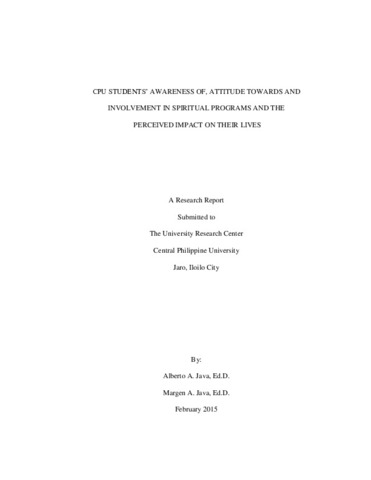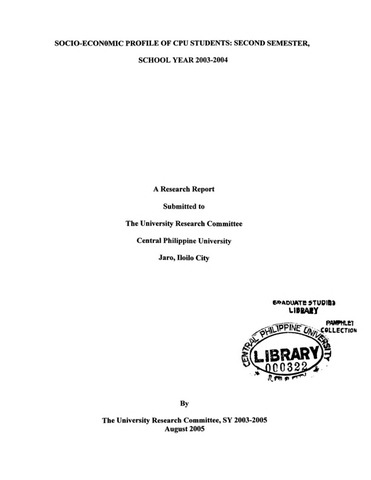The extent of utilization of counseling and classroom guidance services: Its relationship on the college adjustment level of Iloilo Doctors’ College students

Page views
577Date
2011Author
Thesis Adviser
Defense Panel Chair
Share
Metadata
Show full item recordAbstract
This study was conducted to determine the characteristics of Iloilo Doctors’ College students according to sex, age, and course; their extent of utilization of counseling services and classroom guidance services; the variation in their extent of utilization of counseling and classroom guidance services; variation in their college adjustment level; the relationship between their characteristics and social support; the relationship between social support and their college adjustment level, and; the relationship between their extent of utilization of counseling services, and classroom guidance and college adjustment level, and social support as an intervening variable.
The respondents of this study were 207 third year students of various courses namely BS Nursing, BS Radiologic Technology, BS Medical Laboratory Science, BS Commerce and BS Physical Therapy enrolled for the academic year 2009-2010.
This is a descriptive-relational type of study which used a one shot survey design. To determine the level of adjustment of college students, the standardized test, College Adjustment Scale was used. To determine the frequency of utilization of the students of the counseling and classroom guidance, self-made test and counseling logbooks were used.
The data gathered were computer-processed and analyzed using the Statistical Package for Social Sciences (SPSS) version 12. For the descriptive analysis, frequency distribution, percentage and mean were used. T-test was utilized to determine the variation in the students’ extent of utilization of counseling and classroom guidance services and adjustment level according to their sex and age, and Analysis of Variance (ANOVA) was utilized to determine the variation in the students’ college adjustment level according to their course. Chi-square was used to determine the relationship between the students’ social support and their college adjustment level, and the relationship between students’ characteristics and their social support. Gamma was utilized to analyze the relationship between the students’ college adjustment level and their utilization of classroom guidance and counseling services and to determine the relationship between the students’ extent of utilization of counseling and classroom guidance services and their college adjustment level with the intervention of social support. T-test was utilized to determine the variation in the students’ college adjustment level according to their family support, friends support, and church support, and to determine the variation in the students’ college adjustment level according to social support as a whole.
Findings
The results of the study revealed that:
The majority of the respondents were females, aged 19 years old and younger and nursing students. Most of these respondents had not utilized the counseling services despite whatever college adjustment problem they had. However, the majority of the respondents had highly utilized the classroom guidance services.
The T-test showed that the students’ extent of utilization of counseling services did not vary according to their sex and age. Furthermore, ANOVA showed no significant variation on the students’ extent of utilization of counseling services according to their course. The T-test showed that the students’ extent of utilization of classroom guidance did not significantly vary according to their sex and age. However, there was significant variation in the students’ extent of utilization of classroom guidance services according to their course. The T-test statistic showed that there is no significant variation in the students’ college adjustment level when grouped according to their sex and age.
Analysis of variance (ANOVA) showed significant variation in the level of students’ college adjustment specifically in depression, suicidal ideation, substance abuse, interpersonal problems, and career problems according to their course. Moreover, the T-test showed significant difference in the students’ college adjustment level in interpersonal and family problems according to their family support.
The T-test showed no significant difference in all the areas of students’ college adjustment level even with the intervention of peer support. Furthermore, the T-test showed no significant difference in students’ college adjustment level in all the areas according to social support of the respondents. As shown by the Chi-square values, the social support as a whole has no significant relationship with the college adjustment level of the students in all adjustment areas. However, the Chi-square test shows that there was a significant relationship between the students’ sex and their social support. The showed value significant relationship between students’ college adjustment level in suicidal ideation and substance abuse and their extent of utilization of counseling services. There was significant relationship between the students’ college adjustment level in suicidal ideation, interpersonal problems, and career problems and their extent of utilization of classroom guidance services. The test for Gamma relationship shows that there was significant relationship between the students’ extent of utilization of counseling services and college adjustment level in the areas of family problem and suicidal ideation with the intervention of social support. Moreover, there was significant relationship between the students’ extent of utilization of classroom guidance services and their college adjustment level in the area of depression with the intervention of social support.
Conclusions
On the basis of the findings of this study, it is reasonable to conclude that:
In general, the majority of the students did not utilize the counseling services but most of them highly utilized the classroom guidance services.
The majority of the students seemed to be highly to very highly adjusted in most areas of their college adjustment, while a minority of them were poorly to fairly adjusted. The status of students’ college adjustment were deceiving because majority of them seemed to be highly to very highly adjusted. However, there were still some students with adjustment problems which may be critical. The students failed to benefit from the counseling services the since majority of them did not utilize the counseling services. Although the students had the knowledge on the availability of the counseling services in their school, yet they opted not to utilize the said service.
The students’ utilization of classroom guidance services significantly differed according to their courses. The BS Nursing, BS Commerce and BS Radiologic Technology students are the more participative groups as compared to other courses. The Student’s adjustment problems differed from each other depending on which course they were enrolled in. Counselors approaches would also vary according to students’ courses because of the different adjustment problems each student was facing.
Family support is important for students’ adjustment. Students with secure attachments to parents and significant others tended to have an easier adjustment to college than individuals who did not have secure attachments. Furthermore, social support as a whole seemed to be a significant contributing factor for students to less engage in substance abuse and family problems. Students who received social support had lesser tendency to have adjustment problems with substance abuse and family problems. Among the social support, family support was the most significant support for students. Although the majority of students have peer support yet, the support coming from the peers has no significant contribution to their college adjustment. Social support as a whole was not a contributing factor for students to be highly or very highly adjusted in college.
The students’ extent of utilization of counseling services has significant contribution on the students’ adjustment level in substance abuse. Moreover, the students’ extent of utilization of classroom guidance has also significant contribution on the students’ adjustment level in suicidal ideation, interpersonal, and career problems.
The students’ extent of utilization of counseling services with the intervention of social support has bearing on the students’ adjustment in the area of suicidal ideation. Both the counseling services and social support help students with their adjustment problems in suicidal ideation. Furthermore, the students’ extent of utilization of classroom guidance services with the intervention of social support has significant bearing on the students’ adjustment level in depression. Students who have more social support are happier and are less likely to have adjustment problems with depression.
Description
Abstract only
Suggested Citation
Bolivar, M. N. L. (2011). The extent of utilization of counseling and classroom guidance services: Its relationship on the college adjustment level of Iloilo Doctors’ College students (Unpublished Master's thesis). Central Philippine University, Jaro, Iloilo City.
Type
ThesisSubject(s)
Department
School of Graduate StudiesDegree
Master of Science in Guidance and CounselingShelf Location
GSL Theses 371.4072 B638
Physical Description
xxiii, 159 leaves
Collections
The following license files are associated with this item:
Except where otherwise noted, this item's license is described as Attribution-NonCommercial-NoDerivs 3.0 Philippines
Related items
Showing items related by title, author, creator and subject.
-
CPU students’ awareness of, attitude towards, and involvement in the spiritual programs of the university and their perceived impact on their lives
Java, Alberto A.; Java, Margen A. (2015-02)This study was conducted to determine the students’ awareness of, attitude towards, and involvement in the spiritual programs of the university and their perceived impact on their lives. The one-shot survey was used in the ... -
Assessing the guidance and counseling needs of students with special needs in higher education institutions
Imbang, Lei Marie F. (2012)The increase in number of students with special needs in higher education institutions necessitates greater understanding of their needs. The purpose of this study was to determine the guidance and counseling needs of ... -
Socio-economic profile of CPU students: Second semester, school year 2003-2004
University Research Committee (Central Philippine University, 2005-08)This survey was conducted in order to determine the profile of the students of Central Philippine University for the second semester of SY 2003-2004. This study was descriptive in nature and employed the survey approach. ...





